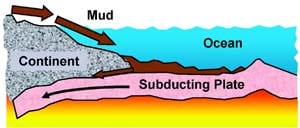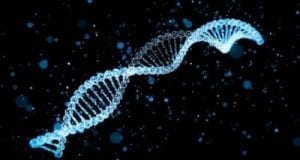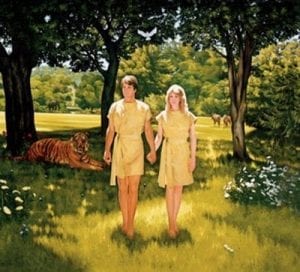A form of creationism which holds that the earth and the universe are approximately 6,000 years old. Young earth creationists hold that both creation and the evolutionary position are at root tied to worldviews, and because they are both claims about historical (or prehistorical) events, they depend on untestable assumptions. At the same time, young earth creation scientists argue that the young universe view is the explanation that best fits the evidence. Scientists who advocate an old earth regard young earth creationism as being unscientific. But the predominantly atheistic scientists rely on a double standard that ignores numerous counterexamples to an Old Earth, and the believers in an Old Earth also over-rely on flawed radiometric dating.1
Biological material decays too fast.
 Natural radioactivity, mutations, and decay degrade DNA and other biological material rapidly. Measurements of the mutation rate of mitochondrial DNA recently forced researchers to revise the age of “mitochondrial Eve” from a theorized 200,000 years down to possibly as low as 6,000 years.17 DNA experts insist that DNA cannot exist in natural environments longer than 10,000 years, yet intact strands of DNA appear to have been recovered from fossils allegedly much older: Neandertal bones, insects in amber, and even from dinosaur fossils.18 Bacteria allegedly 250 million years old apparently have been revived with no DNA damage.19 Soft tissue and blood cells from a dinosaur have astonished experts.20
Natural radioactivity, mutations, and decay degrade DNA and other biological material rapidly. Measurements of the mutation rate of mitochondrial DNA recently forced researchers to revise the age of “mitochondrial Eve” from a theorized 200,000 years down to possibly as low as 6,000 years.17 DNA experts insist that DNA cannot exist in natural environments longer than 10,000 years, yet intact strands of DNA appear to have been recovered from fossils allegedly much older: Neandertal bones, insects in amber, and even from dinosaur fossils.18 Bacteria allegedly 250 million years old apparently have been revived with no DNA damage.19 Soft tissue and blood cells from a dinosaur have astonished experts.20
Too much helium in minerals.
Uranium and thorium generate helium atoms as they decay to lead. A study published in the Journal of Geophysical Research showed that such helium produced in zircon crystals in deep, hot Precambrian granitic rock has not had time to escape.25 Though the rocks contain 1.5 billion years worth of nuclear decay products, newly-measured rates of helium loss from zircon show that the helium has been leaking for only 6,000 (± 2000) years.26 This is not only evidence for the youth of the earth, but also for episodes of greatly accelerated decay rates of long half-life nuclei within thousands of years ago, compressing radioisotope timescales enormously.
Zircons are tiny volcanic crystals. They also are found to contain far more helium and lead than they should — if the earth were “billions of years old.” Humphreys, Austin, Baumgardner, and Snelling have written a paper on this subject as well, and in their summary they said that:
“We contracted with a high-precision laboratory to measure the rate of helium diffusion out of the zircons … Here we report newer zircon diffusion data that extend to the lower temperatures … of Gentry’s retention data. The measured rates resoundingly confirm a numerical prediction we made based on the reported retentions and a young age. Combining rates and retentions gives a helium diffusion age of 6,000 ± 2,000 years. This contradicts the uniformitarian age of 1.5 billion years based on nuclear decay products in the same zircons. These data strongly support our hypothesis of episodes of highly accelerated nuclear decay occurring within thousands of years ago. Such accelerations shrink the radioisotopic “billions of years” down to the 6,000-year timescale of the Bible.” 106 (Emphasis Added)
Fossil radioactivity shortens geologic “ages” to a few years.
Radiohalos are rings of color formed around microscopic bits of radioactive minerals in rock crystals. They are fossil evidence of radioactive decay.21 “Squashed” Polonium-210 radiohalos indicate that Jurassic, Triassic, and Eocene formations in the Colorado plateau were deposited within months of one another, not hundreds of millions of years apart as required by the conventional time scale.22 “Orphan” Polonium-218 radiohalos, having no evidence of their mother elements, imply accelerated nuclear decay and very rapid formation of associated minerals.23,24
Too much carbon 14 in deep geologic strata.
 With their short 5,700-year half-life, no carbon 14 atoms should exist in any carbon older than 250,000 years. Yet it has proven impossible to find any natural source of carbon below Pleistocene (Ice Age) strata that does not contain significant amounts of carbon 14, even though such strata are supposed to be millions or billions of years old. Conventional carbon 14 laboratories have been aware of this anomaly since the early 1980s, have striven to eliminate it, and are unable to account for it. Lately the world’s best such laboratory which has learned during two decades of low-C14 measurements how not to contaminate specimens externally, under contract to creationists, confirmed such observations for coal samples and even for a dozen diamonds, which cannot be contaminated in situ with recent carbon.27 These constitute very strong evidence that the earth is only thousands, not billions, of years old.
With their short 5,700-year half-life, no carbon 14 atoms should exist in any carbon older than 250,000 years. Yet it has proven impossible to find any natural source of carbon below Pleistocene (Ice Age) strata that does not contain significant amounts of carbon 14, even though such strata are supposed to be millions or billions of years old. Conventional carbon 14 laboratories have been aware of this anomaly since the early 1980s, have striven to eliminate it, and are unable to account for it. Lately the world’s best such laboratory which has learned during two decades of low-C14 measurements how not to contaminate specimens externally, under contract to creationists, confirmed such observations for coal samples and even for a dozen diamonds, which cannot be contaminated in situ with recent carbon.27 These constitute very strong evidence that the earth is only thousands, not billions, of years old.
Carbon 14 Dating is Flawed Science
The finding that measurable and reproducible amounts of 14C in fossil material such as coal and other materials previously thought to be very ancient is a powerful refutation of the geological timescale of millions of years. This should force a complete re-examination of the entire scientific system of dating.
It is also necessary to recognize the importance of atmospheric carbon content at the time of death or burial of the sample under test – something impossible to know for most fossils. The concept of uniformitarianism — that “the present is the key to the past” — is simply not true. The ancient atmosphere was different from today’s, and that has a strong effect on determining the date of the sample under test.
In addition, the Creation-vs-Evolution conflict is not a contest between science and religion. Each side uses scientific methods, but also both sides rely on faith. One has faith in God and His Bible, the other has faith in materialistic naturalism. One system is theistic, the other is atheistic.
Radiocarbon in Diamonds
Far from proving evolution, carbon-14 dating actually provides some of the strongest evidence for creation and a young earth. Radiocarbon (carbon-14) cannot remain naturally in substances for millions of years because it decays relatively rapidly. For this reason, it can only be used to obtain “ages” in the range of tens of thousands of years.
Scientists from the RATE (Radioisotopes and the Age of the Earth) project examined diamonds that evolutionists consider to be 1–2 billion years old and related to the earth’s early history. Diamonds are the hardest known substance and extremely resistant to contamination through chemical exchange.
Yet the RATE scientists discovered significant detectable levels of radiocarbon in these diamonds, dating them at around 55,000 years—a far cry from the evolutionary billions!
- For more information, see Radiocarbon in Diamonds Confirmed. To learn more about diamonds and their formation, read this article by Dr. Andrew Snelling.
Agriculture is too recent.
The usual evolutionary picture has men existing as hunters and gatherers for 185,000 years during the Stone Age before discovering agriculture less than 10,000 years ago.29 Yet the archaeological evidence shows that Stone Age men were as intelligent as we are. It is very improbable that none of the eight billion people mentioned in item 12 should discover that plants grow from seeds. It is more likely that men were without agriculture for a very short time after the Flood, if at all.31
Not enough mud on the sea floor.
 Each year, water and winds erode about 20 billion tons of dirt and rock from the continents and deposit it in the ocean.6 This material accumulates as loose sediment on the hard basaltic (lava-formed) rock of the ocean floor. The average depth of all the sediment in the whole ocean is less than 400 meters.7 The main way known to remove the sediment from the ocean floor is by plate tectonic subduction. That is, sea floor slides slowly (a few cm/year) beneath the continents, taking some sediment with it. According to secular scientific literature, that process presently removes only 1 billion tons per year.7 As far as anyone knows, the other 19 billion tons per year simply accumulate. At that rate, erosion would deposit the present mass of sediment in less than 12 million years. Yet according to evolutionary theory, erosion and plate subduction have been going on as long as the oceans have existed, an alleged three billion years. If that were so, the rates above imply that the oceans would be massively choked with sediment dozens of kilometers deep. An alternative (creationist) explanation is that erosion from the waters of the Genesis flood running off the continents deposited the present amount of sediment within a short time about 5,000 years ago.
Each year, water and winds erode about 20 billion tons of dirt and rock from the continents and deposit it in the ocean.6 This material accumulates as loose sediment on the hard basaltic (lava-formed) rock of the ocean floor. The average depth of all the sediment in the whole ocean is less than 400 meters.7 The main way known to remove the sediment from the ocean floor is by plate tectonic subduction. That is, sea floor slides slowly (a few cm/year) beneath the continents, taking some sediment with it. According to secular scientific literature, that process presently removes only 1 billion tons per year.7 As far as anyone knows, the other 19 billion tons per year simply accumulate. At that rate, erosion would deposit the present mass of sediment in less than 12 million years. Yet according to evolutionary theory, erosion and plate subduction have been going on as long as the oceans have existed, an alleged three billion years. If that were so, the rates above imply that the oceans would be massively choked with sediment dozens of kilometers deep. An alternative (creationist) explanation is that erosion from the waters of the Genesis flood running off the continents deposited the present amount of sediment within a short time about 5,000 years ago.
Not enough sodium in the sea.
Every year, rivers8 and other sources9 dump over 450 million tons of sodium into the ocean. Only 27% of this sodium manages to get back out of the sea each year.9,10 As far as anyone knows, the remainder simply accumulates in the ocean. If the sea had no sodium to start with, it would have accumulated its present amount in less than 42 million years at today’s input and output rates.10 This is much less than the evolutionary age of the ocean, three billion years. The usual reply to this discrepancy is that past sodium inputs must have been less and outputs greater. However, calculations that are as generous as possible to evolutionary scenarios still give a maximum age of only 62 million years.10 Calculations11 for many other seawater elements give much younger ages for the ocean.
History is too short.
According to evolutionists, Stone Age Homo sapiens existed for 190,000 years before beginning to make written records about 4,000 to 5,000 years ago. Prehistoric man built megalithic monuments, made beautiful cave paintings, and kept records of lunar phases.30 Why would he wait two thousand centuries before using the same skills to record history? The biblical time scale is much more likely.31
The earth’s magnetic field is decaying too fast.
The Earth’s magnetic field is decaying at the rate of about 5% every 100 years. This means that about 1450 years ago it was twice as strong as it is today, and 2900 years ago it was four times as strong. Therefore, assuming that the rate of decay has been constant for the recent past, then only 10,000 years ago the earth’s magnetic field was 128 times as strong as it is today: so strong that the amount of heat produced would have prevented life as we know it from existing on earth. 23,24,25,26 At the very least this data suggests that life on earth cannot be any older than 10,000 years. More here…
The total energy stored in the earth’s magnetic field (“dipole” and “non-dipole”) is decreasing with a half-life of 1,465 (± 165) years.12 Evolutionary theories explaining this rapid decrease, as well as how the earth could have maintained its magnetic field for billions of years are very complex and inadequate. A much better creationist theory exists. It is straightforward, based on sound physics, and explains many features of the field: its creation, rapid reversals during the Genesis flood, surface intensity decreases and increases until the time of Christ, and a steady decay since then.13 This theory matches paleomagnetic, historic, and present data, most startlingly with evidence for rapid changes.14 The main result is that the field’s total energy (not surface intensity) has always decayed at least as fast as now. At that rate the field could not be more than 20,000 years old.15
Many strata are too tightly bent.
In many mountainous areas, strata thousands of feet thick are bent and folded into hairpin shapes. The conventional geologic time scale says these formations were deeply buried and solidified for hundreds of millions of years before they were bent. Yet the folding occurred without cracking, with radii so small that the entire formation had to be still wet and unsolidified when the bending occurred. This implies that the folding occurred less than thousands of years after deposition.16
The Oldest Living Thing
The oldest living thing on earth is either an Irish Oak or a Bristlecone pine. If we assume a growth rate of one tree ring per year, then the oldest trees are between 4,500 and 4,767 years old. The fact that these trees are still alive and growing older means that we don’t yet know how old they will get before they die. It also strongly suggests that something happened around 4,500 to 4,767 years ago which caused the immediate ancestors of these trees to die off. 13,14,15 Note also that it is possible for trees to produce more than one growth ring per year, which would shorten the above estimated ages of these trees. Also, with regard to fossil tree rings, the author has been unable to find any documented instances of fossil trees having more than about 1500 rings. This is significant since we are told that God (literally) made the Earth, and all that is in it, only about 1800 years before the Noachian Flood described in the Book of Genesis.
Note: In 2013 a Bristlecone Pine tree was discovered that has just over 5,000 tree rings.
Axel Heiberg and Ellesmere Islands
Axel Heiberg and Ellesmere Islands are located in northern Canada, above the Arctic circle. The winters are so cold there that the only “trees” able to grow are small shrubs less than a foot in height.59 However something very strange has been found on these islands that testifies to a very different past: i.e. numerous large trees and tree stumps lying on, or buried just beneath the surface. 60,61,62
How did they get there? And more importantly, when did they get there?
It is claimed that the trees are leftover remnants of forests which inhabited this area 40-65 million years ago. 60,61,62 The scientific data suggests otherwise. For instance, they are not petrified, 60,61,62 but can be sawed and burned. In addition, pine cones and needles, and leaves are also preserved in the sandy/silty soil. 60,61,62 Another clue to the puzzle is that the roots of these trees are missing 60,61,62 — suggesting that they didn’t grow here but were uprooted and later re-deposited (after being transported by a catastrophic event such as a flood). This is also exactly what happened in to the trees that are at the bottom of Spirit Lake near Mt. St. Helens; however, the upright trees on the bottom of this lake are still under water. At some time in the future they may be left standing upright — looking as if they grew there. 63-70
In regard to this, Quiring, states:
“During the eruption many trees from the surrounding hillsides were washed into the lake. Today, thousands of logs, protected within the monument, float back and forth with the changing winds. As some of the trees sink, roots first, they settle upright on the lake floor to form a ‘sunken forest.'” 71
In regard to the preservation of the organic matter on Axel Heiberg Island, an online article states the following:
“The Axel Heiberg fossils are largely preserved as mummifications. Although usually compressed, the wood and other remains are relatively unaltered chemically and biologically (Obst et al, 1991). Preservation of the fossils is exquisite, including leaf litter, cones, twigs, branches, boles, roots, etc. Where these are not compressed, they are virtually indistinguishable from equivalent tissues found in the forest floor of modern conifer forests … The reasons why preservation is exceptional and there is so little mineralization remain obscure. Analysis of the organic remains indicate that they were buried in a fresh-water environment (Goodarzi et al, 1991).” Emphasis Added
Although these trees are frozen for most of the year, each summer the snow melts and for about three months the temperature reaches into the 70 degree Fahrenheit range.72 Such warm temperatures should, under normal conditions, allow decomposition to take place. One explanation for the remarkable degree of preservation is the suggestion that these trees were “mummified” by being buried under significant amounts of strata, and then, over time, this overlying strata was eroded.
This is perhaps possible, however, it is also possible that these trees are not millions of years old, but rather only a few thousand. The fact that the roots of some of these upright trees are missing suggests that they were uprooted by a catastrophe, and transported by water to these islands (perhaps) in the not-too-distant past. Otherwise they would have decayed.
Similar trees from Siberia are only 7,000 years old. For example, in “Cataclysms of the Earth,” by Hugh Auchincloss Brown, on page 31, Mr. Brown makes the following comments:
“In certain areas of northern Siberia innumerable tree trunks called by the natives “Adam’s wood” and said to be in all stages of decay are embedded in the solidly frozen tundra. Because they were once growing trees, of types which do not grow in that climate, they confirm that a change in climate has taken place, such as would be caused by a careen of the globe. They could have been broken by a hurricane or flood. If so, they will show a clean break on the side on which the breaking force was imposed and torn fibers on the lee side. A reexamination of the wood, to determine genera and species of the trees, will enable us to establish the latitude range or climate in which these trees grew.” Emphasis Added
“A so called mammoth tree, with fruit and leaves still on it, was discovered and reported after a landslide of Siberian tundra. Such cold storage of fruit 7,000 years old can only be explained by a sudden transportation of the fruit from a warm climate in which it grew to the cold storage climate in which it has been refrigerated. This specimen of fruit, with leaves, and many other specimens of leaves reported found in Siberia also confirm the careen of the globe.” Emphasis Added
Velikovski’s “Earth in Upheaval” (1955) reported similarly preserved trees in the frozen tundra of Alaska.
See also Discovery of 260 million year old fossil forest from Antarctica, where we find the following:
“The wood was most interesting to me. In some cases branches were preserved, suggesting that the wood had not been transported far by streams. We found an impression of a piece of bark with a knot preserved clearly – not bad for about 250 million years old! The stumps were not replaced by silica, and thus are not “petrified,” but they have been freeze dried in a way that has preserved the growth rings in some cases. On one tree, we counted 26 annual rings, and it was probably older because not all the growth rings were preserved.” Emphasis Added
For more on these trees and other (supposedly very old) material see:
- Carbon Dating of “Fossil” Wood and Unfossilized Dinosaur Bones.
- A Tropical Reptile in the ‘Cretaceous’ Arctic, by Michael Oard
- Sustainability: A Glacial Perspective, Lessons of a 40 Million Year Old Forest, by Richard Jagels
- The Oldest Wood in the World by Carla Helfferich
- Axel Heiberg Absurdities and Ellesmere Island Embarrassments from Malaga Bay
- Scientists Battle over turf in Arctic land that time forgot by Ed Struzik
Dinosaur Soft Tissue
In recent years, there have been many findings of “wondrously preserved” biological materials in supposedly ancient rock layers and fossils. One such discovery that has left evolutionists scrambling is a fossilized Tyrannosaurus rex femur with flexible connective tissue, branching blood vessels, and even intact cells!
According to evolutionists, these dinosaur tissues are more than 65 million years old, but laboratory studies have shown that there is no known way—and likely none possible—for biological material to last more than thousands of years.
Could it be that evolutionists are completely wrong about how recently these dinosaurs lived?
- To learn more, see “Ostrich-Osaurus” Discovery? and The Scrambling Continues. We also recommend the article Fossilized Biomaterials Must Be Young by Brian Thomas of ICR.
Tightly Folded Rock Strata
When solid rock is bent, it normally cracks and breaks. Rock can only bend without fracturing when it is softened by extreme heating (which causes re-crystalization) or when the sediments have not yet fully hardened.
There are numerous locations around the world (including the famous Grand Canyon) where we observe massive sections of strata that have been tightly folded, without evidence of the sediments being heated.
This is a major problem for evolutionists who believe these rock layers were laid down gradually over vast eons of time, forming the geologic record. However, it makes perfect sense to creationists who believe these layers were formed rapidly in the global, catastrophic Flood described in Genesis.
- To find out more, see Rock Layers Folded, Not Fractured.
The earth is only a few thousand years old. That’s a fact, plainly revealed in God’s Word. So we should expect to find plenty of evidence for its youth. And that’s what we find—in the earth’s geology, biology, paleontology, and even astronomy.
The Bible Indicates a Young Earth of approximately 6000 years.
Literally hundreds of dating methods could be used to attempt an estimate of the earth’s age, and the vast majority of them point to a much younger earth than the 4.5 billion years claimed by secularists. The following series of articles presents what Answers in Genesis researchers picked as the ten best scientific evidences that contradict billions of years and confirm a relatively young earth and universe.
Despite this wealth of evidence, it is important to understand that, from the perspective of observational science, no one can prove absolutely how young (or old) the universe is. Only one dating method is absolutely reliable—a witness who doesn’t lie, who has all evidence, and who can reveal to us when the universe began!
And we do have such a witness—the God of the Bible! He has given us a specific history, beginning with the six days of Creation and followed by detailed genealogies that allow us to determine when the universe began. Based on this history, the beginning was only about six thousand years ago (about four thousand years from Creation to Christ).
In the rush to examine all these amazing scientific “evidences,” it’s easy to lose sight of the big picture. Such a mountain of scientific evidence, accumulated by researchers, seems to obviously contradict the supposed billions of years, so why don’t more people rush to accept the truth of a young earth based on the Bible?
The problem is, as we consider the topic of origins, all so-called “evidences” must be interpreted. Facts don’t speak for themselves. Interpreting the facts of the present becomes especially difficult when reconstructing the historical events that produced those present-day facts, because no humans have always been present to observe all the evidence and to record how all the evidence was produced.
Forensic scientists must make multiple assumptions about things they cannot observe. How was the original setting different? Were different processes in play? Was the scene later contaminated? Just one wrong assumption or one tiny piece of missing evidence could totally change how they reconstruct the past events that led to the present-day evidence.
That’s why, when discussing the age of the earth, Christians must be ready to explain the importance of starting points and assumptions. Reaching the correct conclusions requires the right starting point.
The Bible is that starting point. This is the revealed Word of the almighty, faithful, and true Creator, who was present to observe all events of earth history and who gave mankind an infallible record of key events in the past.
The Bible, God’s revelation to us, gives us the foundation that enables us to begin to build the right worldview to correctly understand how the present and past are connected. All other documents written by man are fallible, unlike the “God-breathed” infallible Word (2 Timothy 3:16). The Bible clearly and unmistakably describes the creation of the universe, the solar system, and the earth around six thousand years ago. We know that it’s true based on the authority of God’s own character. “Because He could swear by no one greater, He swore by Himself” (Hebrews 6:13).
Sources:
- irc.org with above references here
- earthage.org
- AnswersInGenesis.org, and Here
More Here:
- https://www.conservapedia.com/Young_Earth_Creationism
- https://creation.com/age-of-the-earth
See Also:
- DOCUMENTARY: Is Genesis History?
- Young Earth Segment – from the above documentary Is Genesis History?
- LECTURE: Scripture and Science Declare a Young Earth
Chronological History of Events Related to the Young Earth Theory:

Research Scientists Stunned to Discover DNA Survey Concludes All Mankind Came from a Single Couple as did Animals at the Same Time

Paper: Recent mitochondrial DNA barcoding results bode well for the recent origin of species

Paper: Genetics Confirms the Recent, Supernatural Creation of Adam and Eve




